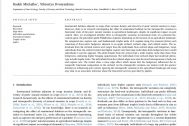Content
Seminatural habitats adjacent to crops often increase density and diversity of pests’ natural enemies in crops. However, there is no research investigating the effect of seminatural habitats on the intraspecific variation in functional traits of the pests’ natural enemies in agricultural landscapes, despite its significant impact on pest control. Here, we investigated whether there is intraspecific variation in functional traits of a potential biocontrol agent, the generalist spider Philodromus cespitum, depending on the location in an agricultural landscape. We compared size, capture rate, and fundamental trophic niche of Philodromus cespitum along five transects (60 m) each consisting of three plots: hedgerow adjacent to an apple orchard, orchard edge, and orchard centre. The individuals from the orchard centers were larger than the individuals from orchard edges and hedgerows. Large individuals from the orchard centers had higher capture rate than large individuals from hedgerows but in small individuals it was the opposite. The adult females from the centers had a wider trophic niche than those from hedgerows, indicating higher foraging opportunism. The individuals from orchard edges had moderate phenotype in both trophic traits. The individuals from the orchard edges were also the most heterogeneous in body size and capture rate. The results show a clear edge effect which means that the hedgerows influenced the intraspecific functional composition in the orchard. As the intraspecific variation can interact with the species’ densities in influencing pest control, ignoring the intraspecific variation in the agricultural landscape and crops may lead to an inaccurate inference about the biocontrol services provided by spiders.



